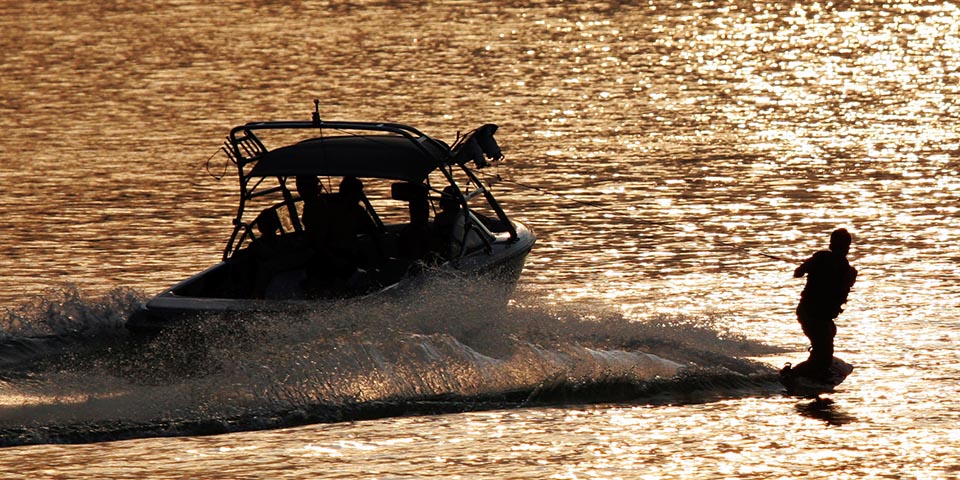Now that Memorial Day, the first official long weekend of summer, has launched us into vacation season, it’s time for a quick reminder about the importance of keeping you and your family safe during your on-water adventures.
The experts at DiscoverBoating.Com offer 10 basic tips for boating safety:
- Be Weather-Wise
Always check local weather conditions before departure. If you notice darkening clouds, volatile and rough changing winds or sudden drops in temperature, play it safe by getting off the water. - Follow a Pre-Departure Checklist
Be prepared for any possibility on the water. Following a pre-departure checklist is the best way to make sure no boating safety rules or precautions have been overlooked or forgotten. - Use Common Sense
Operate at a safe speed at all times (especially in crowded areas), stay alert and steer clear of large vessels and watercraft that can be restricted in their ability to stop or turn. Also, be respectful of buoys and other navigational aids. - Designate an Assistant Skipper
Make sure more than one person on board is familiar with all aspects of your boat’s handling, operations, and general boating safety. - Develop a Float Plan
Whether you choose to inform a family member or staff at your local marina, always be sure to let someone else know your float plan. This should include where you’re going and how long you’re going to be gone. A float plan can include the following information:- name, address, and phone number of trip leader
- name and phone number of all passengers
- boat type and registration information
- trip itinerary
- types of communication and signal equipment onboard
- Make Proper Use of Lifejackets
Assign and fit each member of your onboard team with a life jacket prior to departure. Then wear it! - Avoid Alcohol
Practice boating safety at all times by saving the alcohol for later. The probability of being involved in a boating accident doubles when alcohol is involved and studies have shown that the effects of alcohol are exacerbated by sun and wind. - Learn to Swim
If you’re going to be in and around the water, proper boating safety includes knowing how to swim. - Take a Boating Course
Boater education requirements vary by state; however, some require validated completion of at least one boating safety course. Regardless of your individual state's requirements, it's always important to be educated and prepared for every circumstance that might arise. - Consider a Free Vessel Safety Check
Take advantage of a free vessel safety check from the US Coast Guard. They also offer virtual online safety checks as well.
Speaking of the U.S. Coast Guard, did you know that the USCG has just released a boating safety mobile app? According to their press release:
“The new app was not designed to replace a boater’s marine VHF radio, which the Coast Guard strongly recommends all boaters have aboard their vessels. The app was designed to provide additional boating safety resources for mobile device users.
Features of the app include: state boating information; a safety equipment checklist; free boating safety check requests; navigation rules; float plans; and calling features to report pollution or suspicious activity. When location services are enabled, users can receive the latest weather reports from the closest National Oceanic and Atmospheric Administration weather buoys as well as report the location of a hazard on the water.
The app also features an Emergency Assistance button which, with location services enabled, will call the closest Coast Guard command center.”
Check the Apple or Google Play online stores and download your app before you hit the waves.
What to do in case of pediatric drowning?
We all know kids love playing in and around the water, so we strongly encourage all parents and guardians to take a CPR class that includes the following pediatric skills to be prepared in the event of an emergency.
Due to the direct relationship of drowning and the loss of breathing, the initial approach for a child who is suspected of drowning focuses on getting two initial rescue breaths delivered as rapidly as possible. Immediate rescue breaths could be the only thing necessary to get a child to resume breathing on his or her own.
To care for a suspected drowning:
- With personal safety as a priority, get the child out of the water as soon as possible.
- If the child is unresponsive have another person alert emergency medical services (EMS) and get an automated external defibrillator (AED), if one is readily available. If you are alone, stay with the child and continue care.
- Do not attempt to remove water from the airway or lungs using abdominal thrusts.
- Quickly look at the face and chest for normal breathing. If breathing is gasping or absent, provide two rescue breaths that each make the chest visibly rise, but NO more. Then begin chest compressions.
- Provide continuous cycles of 30 compressions and 2 rescue breaths. If you are alone, provide 5 cycles of 30:2 (about two minutes) before leaving to call for EMS and get an AED yourself.
- If an AED becomes available, turn it on immediately and follow the AED’s voice instructions for using it. Dry the chest before applying pads.
- Don’t stop! Continue until another provider or EMS personnel take over, the child clearly shows signs of life, or you are too tired to continue.
- Be prepared for vomiting when caring for a child who has drowned. If vomiting occurs quickly roll the child on to her side to drain fluid from the mouth. Sweep solid matter out with a gloved finger.
A little advanced prep goes a long way — we hope you’ll consider acting on all today’s tips before you leave the dock this summer.








.png?width=600&name=HSI-CTA-EmergencyCareTraining%20(1).png)











Comments